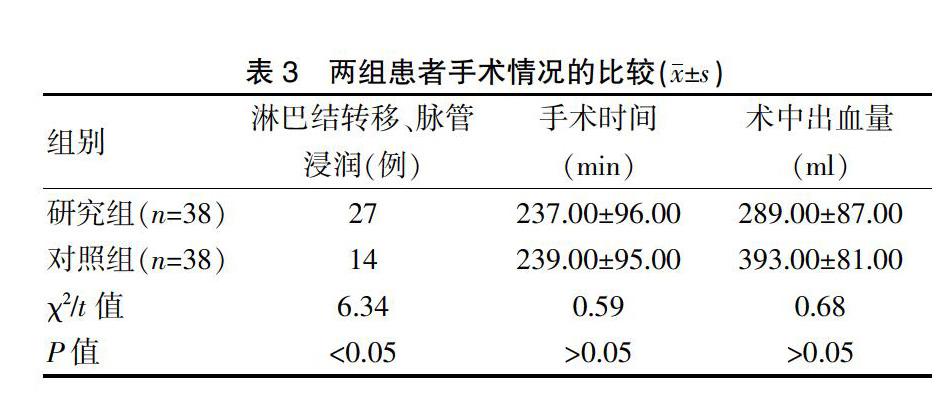新辅助化疗后手术对中晚期宫颈癌的临床效果
2020-10-09韩玉英王庆一康旻
韩玉英 王庆一 康旻



[摘要]目的 探讨新辅助化疗(NACT)后手术对中晚期宫颈癌患者的临床价值。方法 回顾性分析2016 年6月~2019年6月在我院行宫颈癌根治术的76例中晚期宫颈癌患者的临床资料,根据术前是否接受NACT,将其分为研究组(n=38)和对照组(n=38)。通过分析研究组化疗后总有效率及两组患者手术时间、术中出血量、淋巴结转移率及脉管浸润率来评估NACT后手术对中晚期宫颈癌患者的临床价值。结果 研究组患者接受NACT后均成功施行了手术,总有效率为65.79%(25/38),其中CR为0.00%(0/38),PR为65.79%(25/38),SD为34.21%(13/38),PD为0.00%(0/38)。两组患者的手术时间和术中出血量比较,差异无统计学意义(P>0.05);研究组患者的淋巴结转移率及脉管浸润率低于对照组,差异有统计学意义(P<0.05)。结论 NACT后手术对中晚期宫颈癌的疗效较好,能缩小病灶大小,且不增加手术难度,为中晚期宫颈癌患者的治疗提供了又一选择。
[关键词]中晚期宫颈癌;新辅助化疗;宫颈癌根治术;卡铂;紫杉醇
[中图分类号] R739 [文献标识码] A [文章编号] 1674-4721(2020)8(b)-0100-04
[Abstract] Objective To evaluate the clinical value after neoadjuvant chemotherapy (NACT) in patients with middle and advanced cervical cancer. Methods The clinical data of 76 patients with middle and advanced cervical cancer who underwent radical surgery of cervical cancer in our hospital from June 2016 to June 2019 were retrospectively analyzed, and divided them into research group (n=38) and control group (n=38) according to whether they received NACT before surgery. By analyzing the total effective rate after chemotherapy in the research group and the surgery time, intraoperative blood loss, lymph node metastasis rate and vascular invasion rate of the two groups of patients, the clinical value of surgery after NACT for patients with middle and advanced cervical cancer was evaluated. Results All patients in the research group successfully performed surgery after receiving NACT, with a total effective rate of 65.79% (25/38), of which CR was 0.00% (0/38), PR was 65.79% (25/38), and SD was 34.21% (13/38), PD was 0.00% (0/38). There were no significant differences in the surgery time and intraoperative blood loss between the two groups of patients (P>0.05). The lymph node metastasis and vascular infiltration rate of the research group was lower than that of the control group, and the difference was statistically significant (P<0.05). Conclusion NACT before radical surgery of cervical cancer has good effect on middle and advanced cervical cancer, it can reduce the size of cancer, and does not increase the difficulty of surgery, which provides another option for the treatment of patients with middle and advanced cervical cancer.
[Key words] Middle and advanced cervical cancer; Neoadjuvant chemotherapy; Radical surgery of cervical cancer; Carboplatin; Paclitaxel
宮颈癌是最常见的妇科恶性肿瘤之一,据2018年统计,其发病率和死亡率在全球女性癌症中排名第四[1]。据美国2018年统计,约有1.3万女性被诊断为宫颈癌,约4170人死亡[2];2015年据中国统计,约有9.9万人被诊断为宫颈癌,约3.0万人死于宫颈癌,严重威胁女性生命健康[3]。在发展中国家,特别是农村,受医疗条件的限制,待患者表现出不规则阴道流血、双下肢肿痛、尿毒症、贫血等临床症状[4-5]而就诊时已是晚期[6]。目前宫颈癌的标准治疗仍是ⅡA期前患者采用手术为主,故中晚期ⅡB期以上宫颈癌患者错失了手术机会,目前是主张同期放化疗,鉴于部分患者对放疗不敏感,及放疗的近期并发症如骨髓抑制及胃肠道反应,以及远期并发症如放射性直肠炎及膀胱炎的不能耐受,使很多宫颈癌患者丧失治疗机会。我国部分地区放疗设备缺乏、技术相对落后,放疗后导致的并发症及后遗症发生率较高,而先进放疗技术,如三维适形调强放疗等未普及,而且价格昂贵,因此使新辅助化疗(neoadjuvant chemotherapy,NACT)后手术逐渐在一些发展中国家广泛应用[7]。本研究回顾性分析76例在我院行手术治疗的中晚期宫颈癌患者临床资料,通过对比分析中晚期宫颈癌患者NACT后手术及直接手术的临床效果,从而为临床中晚期宫颈癌治疗模式的选择提供参考,现报道如下。
1资料与方法
1.1一般资料
回顾性分析2016 年6月~2019年6月在我院行宫颈癌根治术的76例中晚期宫颈癌患者的临床资料,所有患者均经宫颈活检病理确诊。纳入标准:病理确诊为宫颈癌;术后诊断根据国际妇产科联盟(FIGO,2018年)分期为ⅡA~ⅢC期,统一根据术后病理学最终分期,术后病理提示淋巴结转移为ⅢC期。排除标准:合并其他恶性肿瘤;合并严重心、肝、肾、肺及精神疾病者;合并全身系统及免疫系统疾病者;合并凝血功能障碍者。根据术前是否接受NACT,将其分为研究组(n=38)和对照组(n=38)。研究组年龄28~64岁,对照组年龄27~62岁。两组患者的年龄、肿瘤大小、临床分期、病理类型及分化程度等一般资料比较,差异无统计学意义(P>0.05)(表1),具有可比性。本研究经医院医学伦理委员会批准,每例化疗及手术患者均已签署知情同意书。
1.2方法
1.2.1 NACT 研究组38例术前均接受NACT,采用卡铂+紫杉醇(TC)方案静脉化疗,21 d为1个疗程,共1~3个疗程。紫杉醇(海南全星制药有限公司;生产批号:20190601;规格:16.7 ml∶100 mg)135~175 mg/m2卡铂(齐鲁制药有限公司;生产批号:9J0136B01;规格:0.1 g)200~400 mg/m2,化疗过程中监测血压、脉搏、呼吸等生命体征,并给予补液、止吐、保护胃黏膜治疗。化疗间隔3周。
1.2.2手术方式 研究组末次化疗结束2~3周内手术,患者行腹腔镜广泛性全子宫切除+盆腔淋巴结清扫术+腹主动脉旁淋巴结切除术。对照组患者直接行腹腔镜广泛全子宫切除+盆腔淋巴结清扫术+腹主动脉旁淋巴结切除术。
1.2.3术后辅助治疗 术后病理有高危因素的补充放化疗。术后病理高危因素包括宫旁浸润、盆腔淋巴结转移、阴道切缘阳性,具有上述任何1项,术后补充放化疗[8]。
1.3观察指标及评价标准
通过分析研究组化疗后总有效率及两组患者手术时间、术中出血量、淋巴结转移率及脉管浸润率来评估NACT后手术对中晚期宫颈癌患者的临床价值。疗效评价依据实体瘤疗效评价标准(RECIST)[9],具体如下。完全缓解(CR):所有可见肿瘤病灶完全消失;部分缓解(PR):病灶大小缩小30%以上;疾病稳定(SD):介于PR和疾病進展(PD)之间;PD:病灶大小增加20%以上。其中CR和PR为有效,SD和PD为无效。总有效=CR+PR。
1.4统计学方法
采用SPSS 23.0统计学软件进行数据分析,计量资料用均数±标准差(x±s)表示,两组间比较采用t检验;计数资料采用率表示,组间比较采用χ2检验;等级资料采用秩和检验,以P<0.05为差异有统计学意义。
2结果
2.1研究组患者NACT的效果
研究组患者接受NACT后均成功施行了手术,总有效率为65.79%(25/38),其中CR为0.00%(0/38),PR为65.79%(25/38),SD为34.21%(13/38),PD为0.00%(0/38)(表2)。
2.2两组患者手术情况的比较
研究组患者的淋巴结转移、脉管浸润率低于对照组,差异有统计学意义(P<0.05);两组患者的手术时间和术中出血量比较,差异无统计学意义(P>0.05)(表3)。
3讨论
近年来我国宫颈癌发病率有上升趋势,特别是年轻化趋势明显[10]。目前大部分专家共识ⅡA期前宫颈癌患者治疗方案以手术为主,故对于中晚期ⅡB期以上的宫颈癌患者则丧失了手术治疗的机会,目前是主张同期放化疗。尽管医家们的手术技巧及技术不断改进,放疗设备越来越先进,但有研究显示近40年来宫颈癌的治疗效果无根本提高,总的5年生存率约40%,复发后患者的生存率更低[11]。
晚期宫颈癌病灶大,局部浸润及远处转移,手术复杂等,严重影响预后。有研究表明,影响晚期宫颈癌预后的因素有癌灶大小、组织分化程度、病理类型、淋巴结转移等[12]。特别是病灶大小与宫颈癌的复发密切相关,有研究显示病灶>4 cm的复发机会是<4 cm的4.25倍[13]。20世纪80年代NACT被提出且开始应用于局部晚期宫颈癌的治疗,且最近应用较多。有临床研究显示,NACT在宫颈癌患者中有效率达48.4%~93.0%[14]。专家们已有共识,NACT后行宫颈癌根治术对早期宫颈癌患者效果显著,明显延长患者无进展生存期,且明显改善生活质量[15]。
目前宫颈癌的NACT方案仍以铂类为基础的联合化疗[16-18]。李仪[19]报道紫杉醇联合顺铂(TP)化疗后手术可以改善宫颈癌患者术后临床缓解率,提高5年生存率。Kitagawa等[20]的回顾分析报告指出,TP及TC化疗,两种化疗方案疗效相当,但Lorusso等[21]回顾性研究指出,TC方案较TP方案化疗毒性更低,故本临床研究化疗方案选择TC方案。
多项研究成果表明,局部晚期宫颈癌患者NACT后手术,可提高手术切除率,降低局部及远处淋巴转移率、宫旁转移率和脉管浸润率,提高5年生存率,明显延长了无瘤生存期[22-23]。并且有循证医学显示,NACT与放疗相比,NACT可降低35%的死亡率,增加了近14%的5年生存率[24]。相关研究表明,NACT后手术可以提高癌灶组织的切除率,降低术后病理的高危危险因素:宫旁、盆腹腔淋巴结等的转移率[25],与本研究中晚期宫颈癌NACT后结果一致。
回顾性分析本临床研究38例ⅡA~ⅢC期宫颈癌患者NACT后手术的临床资料,对中晚期宫颈癌患者术前行1~3个疗程的TC化疗方案,结果显示,化疗总有效率为65.79%,化疗后手术成功率为100%。
本临床研究的体会:术前给予1~3个疗程NACT,化疗结束后2~3周内手术,既度过了骨髓抑制期,又避开了化疗后长时间引起的组织机化,故手术均顺利完成。化疗后的毒副反应主要是骨髓抑制和胃肠道反应,经适当补液、止吐、护胃等治疗后患者均可耐受。本研究中所有患者均无重度化疗反应。
本研究结果提示,NACT缩小了病灶大小,改善了宫旁浸润及淋巴结转移,甚至部分可降临床分期,提高病灶手术切除率,使部分原本没有手术机会的患者重新获得了手术的机会,对于中晚期宫颈癌患者,尤其是年轻且希望保留卵巢和阴道功能的患者,NACT后手术较放疗保留了卵巢功能,少数患者还可以保留性功能[26],NACT后手术是中晚期宫颈癌患者的另一选择方案。但也有学者指出,与同步放疗相比,NACT并不能提高晚期宫颈癌患者的5年生存率[27]。但因本研究为回顾性分析,目前随访时间3年左右,无法预测患者5年生存率,要进一步明确NACT后手术对中晚期宫颈癌患者长期生存的影响,还需要今后开展大规模多中心的前瞻性研究来进一步明确。
[参考文献]
[1]Bray F,Ferlay J,Soerjomataram I,et al.Global cancer statistics 2018:GLOBOCAN estimates of incidence and mortality worldwide for 36 cancers in 185 countries[J].CA Cancer J Clin,2018,68(6):394-424.
[2]Siegel RL,Miller KD,Jemal A.Cancer statistics,2018[J].CA Cancer J Clin,2018,68(1):7-30.
[3]Chen W,Zheng R,Baade PD,et al.Cancer statistics in China,2015[J].CA Cancer J Clin,2016,66(2):115-132.
[4]陳渊青,邓必林.宫颈癌预防模式研究进展[J].中国妇幼健康研究,2017,28(5):615-618.
[5]吴绘春,杨菁.新辅助化疗在宫颈癌治疗中的应用研究[J].中国妇幼健康研究,2016,27(10):1258-1260.
[6]Siegel RL,Miller KD,Jemal A.Cancer Statistics,2017[J].CA Cancer J Clin,2017,67(1):7-30.
[7]Minig I,Patrono MG,Romero N,et al.Different strategies of treatment for uterine cervical carcinoma stage IB2-ⅡB[J].World J Clin Oncol,2014,5(2):86-92.
[8]周晖,白守民,林仲秋,等.《2018 NCCN宫颈癌临床实践指南(第一版)》解读[J].中国实用妇科与产科杂志,2017, 33(12):1255-1261.
[9]Therasse P,Arbuck SG,Eisenhauer EA,et al.New guidelines to evaluate the response to treatment in solid tumors[J].J Natl Cancer Inst,2000,92(3):205-216.
[10]Pelkofski E,Stine J,Wages NA,et al.Cervical cancer in women aged 35 years and younger[J].Clin Ther,2016,38(3):459-466.
[11]白璐,李雯慧,陈必良.宫颈癌新辅助化疗的现状与争议[J].现代肿瘤医学,2019,27(7):1278-1280
[12]李龙,赵娟,王月玲.腹腔镜下宫颈癌根治术30例临床分析[J].中国妇幼健康研究,2013,24(2):261-263.
[13]Colturato LF,Signorini Filho RC,Fernandes RC,et al.Lymph node micrometastases in initial stage cervical cancer and tumoral recurrence[J].Int J Gynaecol Obstet,2016,133(1):69-75.
[14]Ye Q,Yuan HX,Chen HL.Responsiveness of neoadjuvant chemotherapy before surgery predicts favorable prognosis for cervical cancer patients:a meta-analysis[J].J Cancer Res Clin Oncol,2013,139(11):1887-1898.
[15]Lapresa M,Parma G,Portuesi R,et al.Neoadjuvant chemotherapy in cervical cancer:an update[J].Expert Rev Anticancer Ther,2015,15(10):1171-1181.
[16]Scandurra G,Scibilia G,Banna GL,et al.Efficacy and tolerability of paclitaxel,ifosfamide,and cisplatin as a neoadjuvant chemotherapy in locally advanced cervical carcinoma[J].J Gynecol Oncol,2015,26(2):118-124.
[17]Gadducci A,Barsotti C,Laliscia C,et al.Dose-dense Paclitaxel-and Carboplatin-based Neoadjuvant Chemotherapy Followed by Surgery or Concurrent Chemo-radiotherapy in Cervical Cancer:a Preliminary Analysis[J].Anticancer Res,2017,37(3):1249-1255.
[18]Chen P,Jiao L,Wang DB.Squamous cell carcinoma antigen expression in tumor cells is associated with the chemosensitivity and survival of patients with cervical cancer receiving docetaxel-carboplatin-based neoadjuvant chemotherapy[J].Oncol Lett,2017,13(3):1235-1241.
[19]李仪.两种新辅助化疗方案治疗宫颈癌的回顾性研究[D].衡阳:南华大学,2016.
[20]Kitagawa R,Katsumata N,Shibata T,et al.Paclitaxel Plus Carboplatin Versus Paclitaxel Plus Cisplatin in Metastatic or Recurrent Cervical Cancer:The Open-Label Randomized Phase Ⅲ Trial JCOG0505[J].J Clin Oncol,2015,33(19):2129-2135.
[21]Lorusso D,Petrelli F,Coinu A,et al.A systematic review comparing cisplatin and carboplatin plus paclitaxel-based chemotherapy for recurrent or metastatic cervical cancer[J].Gynecol Oneol,2014,133(1):117-123.
[22]Fei H,Ke P,Wang N,et al.An evaluation comparing Califomium252 neutron braehytherapy with neoadjuvant intra-arterial embolism chemotherapy assisted surgery effect for treating advanced cervical carcinoma patients[J].Eur J Gynaecol Oncol,2015,36(4):442-446.
[23]Symonds RP,Gourley C,Davidson S,et al.Cediranib combined with carboplatin and paclitaxel in patients with metastatic or recurrent cervical cancer(CIRCCa):a randomised,double-blind,placebo-controlled phase 2 trial[J].Lancet Oncol,2015,16(15):1515-1524.
[24]Ghezzi F,Cromi A,Ditto A,et al.Laparoscopic versus open radical hysterectomy for stage ⅠB2-ⅡB cervical cancer in the setting of neoadjuvant chemotherapy:a multi-institutional cohort study[J].Ann Surg Oncol,2013,20(6):2007-2015.
[25]Liang Y,Lü B,Chen X,et al.Prognostic value of pathological response to neoadjuvant chemotherapy in bulky stage Ⅰb2 and Ⅱa cervical squamous cell cancer patients[J].Virchows Arch,2016,468(3):329-336.
[26]曹澤毅.减少子宫颈癌治疗后的未控和复发[J].中华妇产科杂志,2013,48(4):302-303.
[27]Gupta S,Maheshwari A,Parab P,et al.Neoadjuvant chemo-therapy followed by radical surgery versus concomitant chemotherapy and radiotherapy in patients with stage IB2,ⅡA,or ⅡB squamous cervical cancer:a randomized controlled trial[J].J Clin Oncol,2018,36(16):1548-1555.
(收稿日期:2020-02-27)
